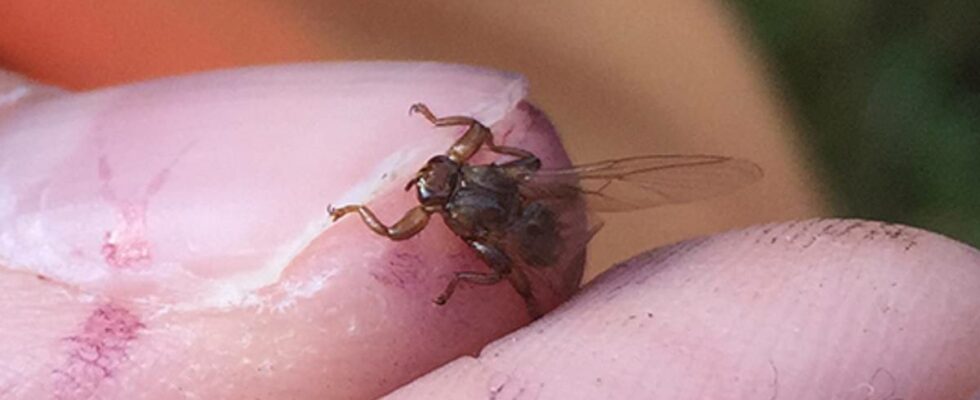The case in summary • The deer louse fly, a blood-sucking parasite that mainly preys on deer, has arrived earlier than usual in Norwegian forests and fields.• Although the deer louse fly can mistake humans for animals, there is no danger to humans. Stings can itch for a long time, but are not dangerous.• Senior researcher at FHI, Bjørn Arne Rukke, advises people in the forest to dress in white to avoid the parasite, as it is less interested in walking on bright objects.• The the early arrival of the deer louse fly is due to the summer heat that was in May. The fly is usually active between August and October.• It is not only the deer louse fly that has invaded forests and fields earlier than expected. In the Oslo area, both mushrooms and blueberries have also been observed. The summary is made by an AI service from OpenAi. The content is quality assured by news’s journalists before publication. The deer louse fly was already found in Norwegian forests and fields in mid-July. It is earlier than usual, says senior researcher at FHI, Bjørn Arne Rukke. – The parasite is usually only active in autumn. Blood-sucking parasite The deer louse fly is a blood-sucking parasite that mainly preys on deer such as roe deer, moose and deer. Nevertheless, it sometimes happens that the fly gets confused, says Rukke. – Then they can mistake humans and animals, and they also end up on us instead. Senior researcher at FHI, Bjørn Arne Rukke. Photo: Hallgeir Aunan Despite a possibly spooky visit, there is no danger to humans. – Usually they don’t sting people, but if they do, the sting can itch for a long time, says the senior researcher. He advises people in the forest to dress in white if they want to avoid the parasite. – The deer louse fly is less interested in walking on bright objects. – Was bitten the other day Sognsvann in Oslo is a popular starting point for trips into the forest in Nordmarka. news took the trip there to hear what hikers think about the early arrival of the deer louse fly. Hallgeir Braastad Always looks after Leif Ryvarden says he has been out in the forest a lot this summer, but so far he has not noticed anything about the deer louse fly. – I try to stay a bit away from undergrowth, but today I might get some on me. Despite the fact that he has not yet encountered the parasite, he is always prepared. – I look out every time I go and check if there is something on my clothes or body when I get home. Hallgeir Braastad Has been scratched a couple of times Farah Mowlud says that she has never heard of the deer louse fly, but suspects that she may have been bitten. – I’ve scratched a couple of times when I’ve been out and about. Nevertheless, she does not do much to protect herself from the parasite. – I scratch if I need to scratch, but I have most likely forgotten about it by the time I get home. Hallgeir Braastad – We are not happy about that. Rikke Bonnevie and Fredrikke Horn Hansen are on a trolley ride. – What do you think of the deer louse fly already being active? – No, we are not happy about that, says Bonnevie. – Have you seen anything about the parasite ? – No, but we have seen other insects on trees. Hallgeir Braastad – Got bitten the other dayOdd Hegge is on a little exercise round in the bad weather. He also hasn’t seen the deer fly yet, but thinks he may have already been bitten. – I was bitten the other day, in the leg, so it may very well have been that. – What do you think about the fact that it is already active? – No, there are only more and more insects coming, from below or from outside, Hegge grins. The fine weather in May is to blame The summer heat that was in May is the reason why the parasite is already here, believes Rukke. – We know that from previous years where it has been good and warm early on, they can come at the end of July as well. Usually the fly is not active until between August and October. Then it flies and finds its prey. After finding a host, it sheds its wings. Photo: Frode Meskau According to Rukke, FHI has no record of whether there has been an increase in the number in recent years. – It is difficult to answer, but it does have certain limits in terms of how far north it can go due to low temperatures. Have you seen the deer louse this year? 🦟 No, I haven’t been out in the forest that much 🌳 Yes, I’ve seen it 😨 I have no idea what it looks like 🤔 Show result Autumn has come early this year It’s not just the deer louse fly that has invaded forests and fields earlier than expected . In several places in southern Norway, mushrooms have also been observed since mid-July. Like Rukke, zoologist Petter Bøckman also points to the climate. – The winter season is shorter and the summers longer, and then nature will appear a little different to us, because it grows at a different rate than what we are used to. Zoologist at the Museum of Natural History, Petter Bøckman. Photo: Berit Roald / NTB He does not think the development will stop anytime soon. – Hopefully, nature will find a lease that works well for both people and animals. But that’s how it is to live in a world that is changing, he says and adds: – You get to see strange things that you might not have expected to see. Published 24/07/2024, at 12.08
ttn-69
The deer louse has arrived earlier than usual this year – Greater Oslo

